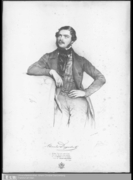Happy 200th Birthday to Alexander Dreyschock!
Kristina Krämer
Monday, October 15, 2018

The following article was contributed by Kristina Krämer, who is currently writing her master’s thesis on Alexander Dreyschock at the Johannes Gutenberg University of Mainz:
Born on 15 October 1818 near Prague, pianist Alexander Dreyschock spent most of his life travelling throughout Europe and competing with the likes of Liszt and Thalberg. At first only known as a pupil of Václav Jan Tomášek, he soon became famous for his strong yet dexterous left hand and overall fiery piano playing. Furthermore, he was a productive composer—until his death in 1869, he published more than 140 compositions with opus numbers.
Amongst the small number of 21 results in the RISM online catalogue referring to him, there are autograph manuscripts like an album leaf in E minor which is dated Frankfurt, 11 December 1843. Today this leaf is housed in the collection of the Frankfurt University Library (D-F, Mus. Hs. 884) but just like his portrait pictured above, it once belonged to the collection of Manskopf’s Museum in Frankfurt. Dreyschock spent the last months of 1843 in the Rhine-Main area where he likely composed the album leaf for an acquaintance as a gift or souvenir—nothing more can be ascertained for now. By that time his reputation both as a composer and pianist preceded him.
The year 1843 marks an important spot in his career: while he had already successfully given concerts in several German, Polish, Czech and Russian cities, he had neither been to Paris nor to London. Dreyschock arrived in Paris in January 1843 where he spent three months giving about a dozen concerts, many of them at Salle Erard, playing some of his own (yet unknown) compositions.
At the same time, Parisian publishing houses like Maurice Schlesinger started printing his piano pieces and La France Musicale added his Nocturne or Bluette op. 16 as giveaway with their January 22 issue. This piece had previously been published by J. Hoffmann in Prague (1842) and is likely his most popular piece. It remained popular for several decades, saw different arrangements and circulated around the globe in many editions. Hofmeister in Leipzig alone, for example, produced 8,750 copies between 1844 and 1858 and continued to print the Nocturne well into the 20th century. It comes as no surprise that the RISM online catalogue contains five manuscript collection entries featuring this Nocturne.
Back to the year 1843: After being pronounced the new discovery of the season, Dreyschock left Paris in April and continued his success in London, where he took part in concerts at the court. August and September were mostly spent recovering near the banks of the river Rhine until Dreyschock continued his activities using Frankfurt as his base to visit the surrounding area. He performed in Mainz, Darmstadt, Wiesbaden, Offenbach and Hanau. The setting of these concerts differed considerably—some of them were large events for charitable purposes, some private. The Allgemeine musikalische Zeitung summed up his success: “However, he aroused enthusiasm in the surrounding towns […] whose audiences drowned him in celebrations, wreaths and sonnets.” (AmZ 21.2.1844). He also received an honorary diploma from the Liederkranz in Frankfurt and was appointed court music director of the grand duke of Hessen-Darmstadt. A poem biding him farewell from Offenbach could be read in a local newspaper (Didaskalia 4.12.1843):
An Alexander Dreyschock.
(Zum Abschied von Offenbach.)
Dem Künstler ward das schöne Loos beschieden,
Uns mit dem Ernst des Lebens zu versöhnen,
An Edleres die Sinne zu gewöhnen
Und unserm Geist Erquickungen zu bieten.
Es sind die Priester, die die Flamme hüten,
Die reine Gluth des Guten und des Schönen;
In Bildern, wie in Worten und in Tönen
Erfreu’n uns ihres Genius reiche Blüthen.
So hast auch Du, ein Liebling der Camöne,
Uns mit dem Zauber deiner Kunst beglücket,
Du hoher Meister in dem Reich der Töne.
Nimm unsern wärmsten Dank dafür – er drücket
Zum Lebewohl die Hand Dir jetzt, die flinke,
Doch nicht die rechte nur, auch Deine linke.
Am 2. Dezember 1843. Joseph Pirazzi.
Image: “Alexander Dreyschock, Kniestück,” lithograph by Josef Kriehuber. Universitaetsbibliothek Johann Christian Senckenberg (Frankfurt am Main) S 36/G04012. Available online.
Share Tweet EmailCategory: Musical anniversaries

